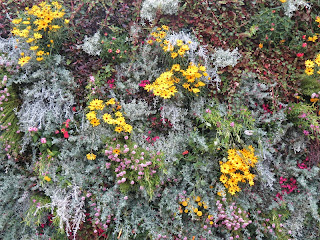No doubt the home supporters among you have been wondering how the Brits got on.
There were two gardens from British designers at the Gardening World Cup, by
Jo Thompson and
Richard Miers, both quite different interpretations of the peace theme.
Actually it's slightly cheating including Jo in the British contingent as she was representing Italy (James Basson, too, is a candidate for the Brit team, being an Englishman who lives in France). She comes from Italian stock, so she's allowed to defect temporarily, but she's on our side really.
Anyway, Jo won a silver medal (equalling her medal from last year's show) for her stone-arched garden, taking its inspiration directly from what happened at Nagasaki almost 70 years ago.
Richard, making his first show garden here (now that's a baptism of fire if ever there was one) was awarded bronze for his very English garden that simply embodied the everyday peace we all feel when we kick back and relax of an evening in a beautiful garden.
I thought I'd shut up for once and let them talk about it in their own words.
Jo Thompson: The Butterfly Effect
"The garden is a direct response to a visit last year that we made to the Nagasaki Peace Museum... It really sunk home quite how important this message [of peace] is.
"What stayed with me were the images of these atomic shadows, which are the remnants of people who were essentially vapourised by the bomb. The people have disappeared but their shadows still remain on the concrete walls: you've got somebody sitting waiting for a bus, a ladder with a man up it going about his daily business - and all of that is just spine-tinglingly awful and it does make your blood run cold.
"Then next to these shadows were some wooden window shutters which had survived, and onto them there had been imprinted the shadow of the acer leaves on the tree that had stood in front of them, and it was beautiful, the most intricate pattern.
"And I found myself standing in front of it thinking, well this is beautiful but in fact it's come from something so ugly. And I wanted to use that.
"So that was the first idea - and then as we walked out of the museum we were met by a host of butterflies. It was extraordinary - we came out from this place of gloom and were just met by them flying around, their fragility contrasting with the sadness of the place we'd just been.
"So I've designed a space that has rendered walls for shadows, it's a very plain, simple floor surface for shadows; it has arches in it to frame shadows, and plants that attract butterflies."
Richard Miers: Serenity
"It's a garden to entertain in: to get people to sit down and have a meal and discuss and talk, aiming for peace and tranquillity.
"The theme of the whole show was gardens for peace - my interpretation was peace within oneself, which you get being out of doors in a nice garden with wildlife all around you, the sound of the running rill - it all just helps you bring peace to yourself.
"The Japanese love asymmetry, and Europeans tend to like symmetry, and I wanted to show them what an English town garden could look like.
"I wanted to bring elements of water, I wanted to bring in the sun, represented in Emily Young's sculpture, and show them how an English herbaceous border would be put together but using Japanese flowers.
"It's getting the rhythm around the garden, having the space to breathe between the flowers which I thought was important."

























































